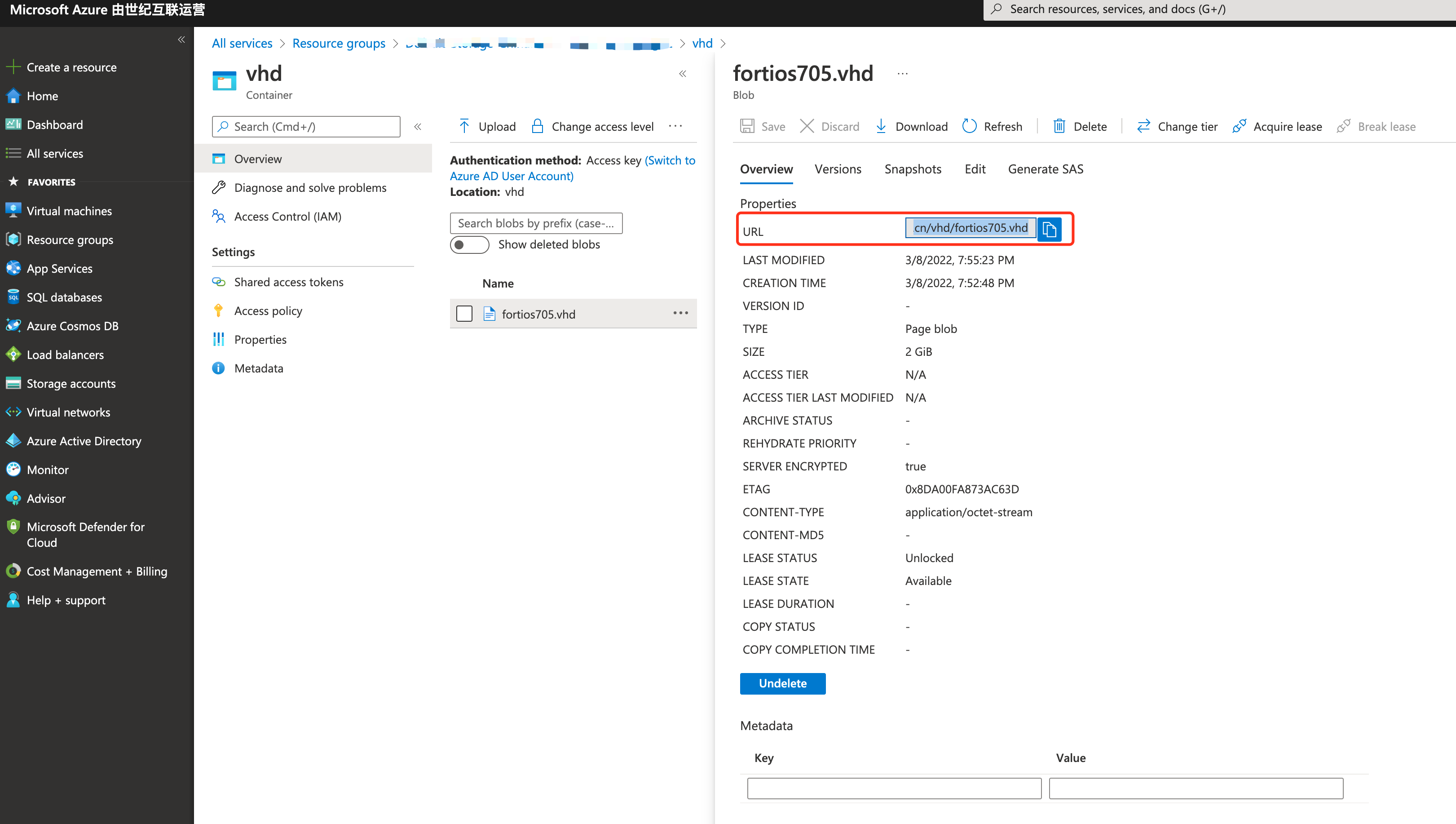为了简化在Azure China上部署FortiGate HA的时间,尝试在Azure China使用Terraform来部署,本文记录在Azure China使用Terraform过程,并指出需要注意的问题
我使用的是Global GitHub上的terraform HA脚本,看了下大致的HA框架都已经有了,只要修改里面的参数,可以在Azure China上工作就可以了,Global GitHub的链接如下
fortigate-terraform-deploy/azure/7.0/ha-port1-mgmt at main · fortinet/fortigate-terraform-deploy
根据Readme提示,需要修改tfvars文件terraform.tfvars.example,删除example的后缀名,填入账号信息,在terraform registry Azure的官方文档上提到,如果要部署在不同的环境需要加上environment参数,类似Azure CLI中也需要使用az cloud set -n AzureChinaCloud来指定登录的区域,默认为public
environment - (Optional) The Cloud Environment which should be used. Possible values are
public,usgovernment,german, andchina. Defaults topublic. This can also be sourced from the ARM_ENVIRONMENT Environment Variable.
在terraform.tfvars增加environment_id,并在相关的引用variables.tf,provider.tf中增加environment参数,terraform.tfvars配置如下
// Change to your own azure environment
subscription_id = "<fill your subscription id>"
client_id = "<fill your cient id>"
client_secret = "<fill your client secret>"
tenant_id = "<fill your tenant id>"
environment = "china"详细信息参考Terraform Registry中Azure provider的详细描述
Terraform支持4种登录方式,我选择的是Authenticating using a Service Principal with a Client Secret这种方式,根据文档操作得到对应的信息填入terraform.tfvars
$ az account set --subscription="SUBSCRIPTION_ID"
$ az ad sp create-for-rbac --role="Contributor" --scopes="/subscriptions/SUBSCRIPTION_ID"使用上述命令操作后,就能得到terraform.tfvars中所需要用到的信息
{
"appId": "00000000-0000-0000-0000-000000000000",
"displayName": "azure-cli-2017-06-05-10-41-15",
"name": "http://azure-cli-2017-06-05-10-41-15",
"password": "0000-0000-0000-0000-000000000000",
"tenant": "00000000-0000-0000-0000-000000000000"
}由于**区不支持Global Maketplace的镜像,在Terraform code中有一段自定义镜像的开关,默认为false,修改为Ture后就可以使用自定义镜像的方式创建虚拟机
在variables.tf中将默认值修改为true
// To use custom image
// by default is false
variable "custom" {
default = true
}使用自定义镜像方式后,会使用到创建自定义镜像的3个参数,
customuri镜像存储的blob地址
custom_image_name为镜像命名
custom_image_resource_group_name镜像所在的资源组,注意自定义镜像的资源组所在的区域需要与部署的区域相同
// Custom image blob uri
variable "customuri" {
type = string
default = "<custom image blob uri>"
}
variable "custom_image_name" {
type = string
default = "<custom image name>"
}
variable "custom_image_resource_group_name" {
type = string
default = "<custom image resource group>"
}在terraform.tfvars中增加了location,customuri,custom_image_name,custom_image_resource_group_name
// Change to your own azure environment
subscription_id = "<fill your subscription id>"
client_id = "<fill your cient id>"
client_secret = "<fill your client secret>"
tenant_id = "<fill your tenant id>"
environment = "china"
location = "chinaeast2"
customuri = "https://xxx.blob.core.chinacloudapi.cn/vhd/xxx.vhd"
custom_image_name = "FGT_VM64_AZURE-v7.0.5"
custom_image_resource_group_name = "xxx"上传镜像文件到blob
Azure镜像文件可以通过support网站下载到
以7.0.5为例,文件名如下,解压后就可以获得vhd文件
FGT_VM64_AZURE-v7.0.5-build0304-FORTINET.out.hyperv.zip
默认提供的镜像为Dynamic,需要通过Hyper-V工具转换为Fixed,转换命令如下
PS C:\WINDOWS\system32> Convert-VHD -Path "D:\Azure\fortios705.vhd" -VHDType Fixed
位于命令管道位置 1 的 cmdlet Convert-VHD请为以下参数提供值:DestinationPath: d:\fortios705.vhd
PS C:\WINDOWS\system32>把转换后的vhd文件上传到blob中,复制文件的URL写到terraform.tfvars
初始化terraform module
$ terraform init查看terraform plan是否正常运行
$ terraform plan确认以后使用apply开始部署
$ terraform apply整个创建的过程大约需要10分钟左右,运行成功后,可以得到如下的输出
Outputs:
ActiveMGMTPublicIP = <Active FGT Management Public IP>
ClusterPublicIP = <Cluster Public IP>
PassiveMGMTPublicIP = <Passive FGT Management Public IP>
Password = <FGT Password>
ResourceGroup = <Resource Group>
Username = <FGT admin>在Azure上部署FortiGate native HA需要创建相当多的对象,使用Terraform可以大大减少环境搭建的时间,本文中修改后的脚本已经上传至github,修改terraform.tfvars就可以使用。
